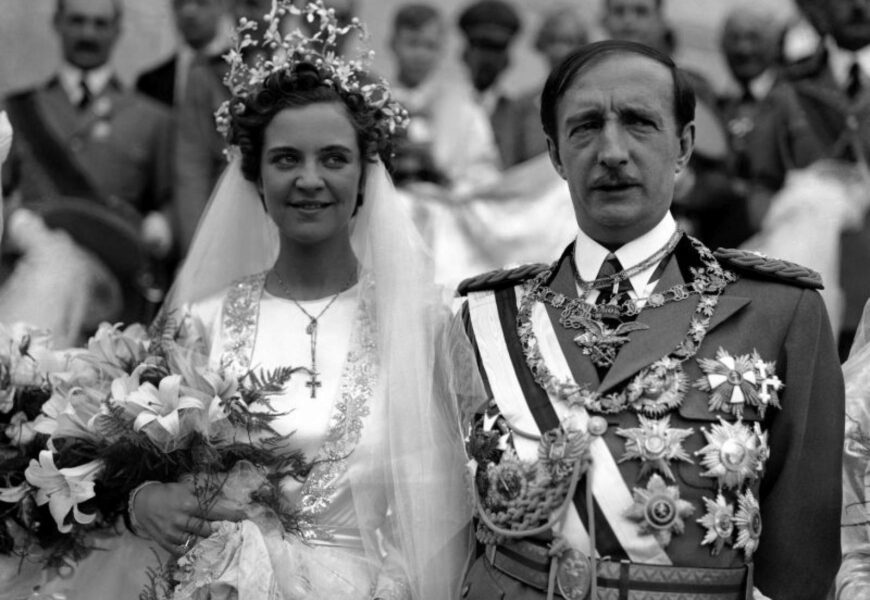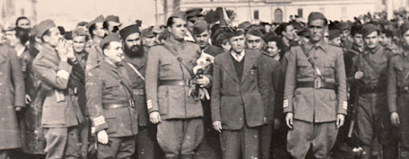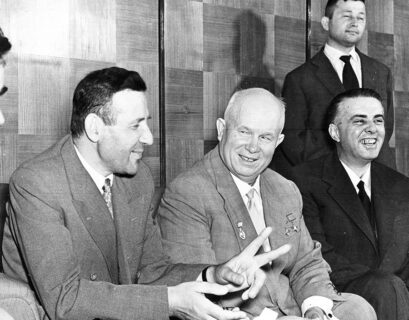by Menyhart Lilla
- The White Rose of Hungary – Geraldine’s early years in the shadow of World War I
Countess Geraldine Apponyi of Nagyappony was born on 6 August 1915 in Budapest, then part of the Austro-Hungarian Empire. The beginning of her life was also an interesting one: the armed conflicts of the First World War were already in full swing and the world was watching the future of the countries with a keen eye.
Geraldine’s family background can be also a great discussion, as she is a descendant of the Hungarian noble Apponyi family. Her father, Count Gyula Rudolf Apponyi, had a military career and served in the Hussar regiment, but was also an MP for the Liberal Party in Parliament.
During World War I, Gyula held a director position in the National Office of the Army and maintained his noble activities throughout the years.[1] Gladys Virginia Stewart, Geraldine’s mother, is an American-born lady from a family of millionaire diplomats.
Not too long after Gyula and Gladys met, some months later they got married in Geneva, Switzerland, and raised three children over the years – Geraldine, Virginia and Gyula. Both parents had the opportunity to experience growing up in an intellectual, educated environment, so they passed on the same curiosity for knowledge for their children. The family’s life was overshadowed by the aftermath of the First World War and as Hungary was defeated, it seemed difficult to emerge from the crisis.
The Apponyi family survived the turbulent years in Switzerland and returned to Hungary in the early 1920s, when they had to face further losses: most of the country’s territory was annexed to other states and the head of the family, Gyula Apponyi, died in 1924.[2] Gladys did not delay long in finding a new partner and two years later, in 1926, she married Gontran Girault, a French officer: the family moved to France and the family expanded with new children, who became half-siblings of the Apponyi children.
In the meantime, the link with the Hungarian nobility had not been completely severed and Geraldine along with her ssiter, Virginia spent summer vacations at the Apponyi estate.[3]
The village of Zebegény, near the Danube, was an important place in Geraldine’s childhood: her aunt Franciska Apponyi bought several farmhouses in the village and organised summer camps for children with the help of her family. The success of the educational endeavour made visitors refer to Franciska’s houses as “children’s republic”, where several houses were named after flowers.
The main focus was on nature-related education, but the participants were also introduced to drama plays and gardening. Geraldine’s beauty earned her the membership name ‘White Rose’ from her aunt and hence the Countess’s special nickname.[4] The two girls, Geraldine and Virginia, were sent by their mother to study at the Sacre Coeur convent school in Austria, where they lived under strict conditions in such a Catholic institution among other noble students.[5] Although she spent relatively little time in Hungary and most of her time she was travelling around Europe, Geraldine found recognition in Budapest as an amateur actor playing the character of Mimi in the play ‘Bohemian Life’ at the Opera Ball and was well received by the audience.[6]
After completing her studies, Geraldine returned to Hungary again, but faced new obstacles: the post-war crisis was still testing the country’s economy to the extent that she, unlike the average countess, had to take on work. With family help, she found her way into the National Museum’s gift shop and sold souvenirs until an invitation came for her from Albania[7].
2. A self-made man – short summary of Zog I’s a monarchy in Albania
On 8 October 1895, Ahmet Muhtar Zogolli was born, who would later be known as King Zog I in Albanian history. He has had a wide-ranging political career, having worked in the public sector from a young age and holding strong reformist views. Although he considered it important to preserve the Albanian identity, he believed that development was essential for the country’s future and wanted to orient his homeland’s development process towards Europe.[8]
In 1908 he became the leader of Mat region and at the suggestion of his mother, Sadije Toptani, he went to study at the Galatasaray Lyceum in Istanbul to stay away from clan politics. 1912 was an eventful year for him, as he took part in the struggle against the Young Turk movement and represented Mat at the proclamation of an independent Albanian state, but he also successfully fought the Serbs the following year.
At the outbreak of World War I in 1914, Zog supported William of Wied’s brief regency as Prince of Albania and became an even more influential figure in the country over the next decade.[9] He served as President of Albania from 1925 to 1928, and on 1 September 1928 he proclaimed himself King and defined his country’s form of government as a democratic constitutional hereditary monarchy.
Taking his royal oath on both the Quran and the Bible, Zog I, who is also a Muslim, promised at his inauguration that Albania’s independence, territorial freedom and constitution would be his top priorities under his rule.[10]
Zog took his promises for the development of Albania seriously and proclaimed Tirana as the capital, which also functioned as a cultural centre for the Albanians. A new infrastructure was built and many buildings were constructed, including institutions such as hospitals. Religious tolerance was important to the King, as he stated in his inaugural oath. He did not deviate from this principle and banned the former Ottoman law of mandatory veil-wearing for women.
Both Christianity and Islam coexisted peacefully in Albania with the spirit of religious harmony, but Zog did not turn his back on the Jews either when he gave shelter to refugees fleeing Nazi persecution in the 1930s.[11]
Although always aiming for independence, the backwardness meant that help had to be sought from other countries, so the Zogist period was one in which the king was open to foreign capital and had closer relations with Italy in particular, which would shorten the life of the Albanian monarchy in later years.[12]
One of the most important turning points during Zog’s reign was the introduction of the Civil Code in 1929, which was based on French and Swiss models, thus moving closer to European inspired developments.
The document consisted of 4 books: the first part dealt with the rights of families and individuals, and also set out the conditions for citizenship. The second part dealt with inheritance, and the third chapter set out the rules on property. Finally, the last section of the Code contained the rules of contract law.[13]
As Zog was a self-made king, in order to secure the future of the monarchy he had to find a partner, which finally brought success in the second half of the 1930s.
3. Engagement and wedding in Tirana
During Zog’s reign, he also thought about maintaining the dynasty, but he had to find himself a wife to ensure its survival. It was not easy for him, however, as he himself was not descended from a royal family and had transformed Albania into a monarchical state as a self-made man: he nevertheless tried to incorporate royal traditions into everyday life, but he still had a difficult task for the future.
As Zog led his country as a Muslim, four other religions also lived peacefully side by side – the religion of the future wife was also a key issue for the country. By the end of the 1930s his ideas had become clearer and he wanted to find himself a Catholic bride: he had no luck in Vienna, but his attempts in Budapest were not in vain.[14]
In 1937, on the 25th anniversary of Albania’s independence, a series of events were organised to commemorate the important date and Zog decided to invite Hungary to be the guest of honour because of the good historical relations between the two countries. Baron Frigyes Villani, a diplomat working as Hungarian envoy in Rome was also in charge of Albanian affairs and became a great help to the King in choosing a bride.[15]
There were Hungarian noblewomen with whom Zogu was rumoured to have tried to meet and propose marriage, but these attempts were unsuccessful and finally, Countess Geraldine Apponyi was the solution for the Albanian ruler. Zog’s sisters also intervened to find a suitable match for their brother: in 1937, they travelled to Budapest and, after spending time with Geraldine, asked the Countess to give them the medallion around her neck as a memory.
Zog was reportedly immediately attracted by the picture of Geraldine and decided to invite the Apponyi girl, who by that time was in Abkhazia, to the New Year’s Eve ball to be held soon in Tirana. After Geraldine received the long invitation letter, she phoned her guardian in Budapest and Károly Apponyi approved the travel plans, so Geraldine left for Albania the next day.[16]
The Hungarian press was also interested in the coverage of the event and it was reported that the ball went so well that Zog and Geraldine fell in love immediately and the King soon afterwards urged the engagement. The news was reportedly sensational in the Apponyi family circles and they arrived in Tirana at the end of January to celebrate the engagement.[17]
By the time of the wedding, the religious differences had been resolved, and the Catholic head of church himself gave permission for Geraldine to marry Zog, a Muslim, on condition that the wedding ceremony was held in the traditions of both religions. In addition, the king granted his future wife the rank of princess and agreed to the free practice of her religion, just like as he had also granted this right to the Albanians.[18]
The wedding on 27 April 1938 was a day of celebration in Albania, with the opening of the road between Durrës and Tirana and the new airport, a military parade and the laying of a wreath on the grave of Sadije Toptani, Zog’s mother.[19]
Another interesting fact about the event: the King also paid the wedding expenses of 100 other couples marrying on the same day, in honour of the fact that centuries ago, on this day, the Albanian national hero Gjergj Kastrioti and his wife Donika Arianiti-Muzaka got married.[20] Representatives of the world press also arrived in Tirana, but several noble families from Hungary also attended the wedding ceremony.
The civil ceremony wedding was held in the hall of the Royal Palace in Tirana, followed by a 101 gun salute and bells ringing to announce the marriage of the royal couple. One of the king’s witnesses was Count Ciano: the same Ciano who was Mussolini’s son-in-law and soon afterwards the excessive Italian influence in Albania would cause fatal problems for the monarchy.
4. Short fairytale of Geraldine
After the wedding, Geraldine became Queen of Albania and did her best to play her fair part in helping and developing the country. Queen Geraldine has always made the welfare of Albanians and helping the poor her priority: she has been involved in many initiatives that have contributed to the building of institutions such as hospitals, asylums, maternity wards and orphanages. She was involved in improving the status of women and emancipation in the country: the Queen always supported the running and development of the military hospital in Tirana and was responsible for the establishment of the first maternity hospital.[21]
In addition to Geraldine’s philanthropic work, she settled into her new country very well and quickly became fluent in Albanian: her radio speech to the Albanian nation in Burgayet on 29 August 1938 is a memorable one in local history.[22] It is also interesting to note that the royal family is credited with the establishment of the first radio in Tirana: on 28 November 1938, on Independence Day, King Zog and Queen Geraldine both addressed the Albanian people on the air and Radio Tirana began broadcasting.[23]
Soon the royal family expanded: on 5 April 1939, the heir to the throne, Leka, was born, but the family’s joy did not last long, because two days later the fascist Italian troops under Mussolini invaded Albania and the king had to go into exile with his family.[24]
5. Decades spent in exile
The excessive Italian influence was fatal in Albania, as the fascist forces invaded the country in early April 1939. Prior to this, on 25 March, Mussolini sent an ultimatum to King Zog, which included the following conditions: an Italian customs union and military troops in towns and villages, the involvement of Italian settlers in agriculture and, last but not least, the sending of an envoy to the Albanian Council of Ministers.
Zog tried to protect the pregnant Geraldine from the stress, but there was not much time to act: two days after Leka’s birth, on 7 April 1939, the Italian army invaded Albania. After a short farewell, the mother and baby set off southwards in a convoy of cars towards Korçë and crossed the Greek border after long hours in difficult conditions. In the meantime, according to news reports, Durrës had already come under Italian control and Vlorë was being bombed from the sea.
Zog joined his family five days later and in the meantime, the Italian King Victor Emmanuel III took control of Albania until the end of World War II – his rule was ended after Enver Hoxha had consolidated the communist regime in the country.[25]
Zog’s destination was France, which seemed safe, and from there he intended to organise his plan for the liberation of Albania. The royal family and their entourage travelled across Europe through countries where fascism had not yet taken root: after Greece, through Turkey, Romania, Poland, the Scandinavian countries and Belgium, they finally arrived in Versailles, France. However, they could not stay here for long, because France was soon occupied by the Nazi German forces and they were able to flee towards the United Kingdom only hours before the invasion.
The Ritz Hotel in London and later Parmoor Village was home to the family until they arrived in Alexandria, Egypt in 1946 at the invitation of King Farouk of Egypt. Zog visited the US in the early 1950s and bought the Knollwood Estate, but the royal family never moved there and a few years later the land was put up for sale. In 1952, President Nasser took power in Egypt and times were difficult both politically and family-wise: Zog felt less support in Alexandria, but at the same time his health began to deteriorate.
The long journey ahead made it impossible to move overseas and the destination was France once again. April seemed to be an eventful time for the Albanian royal family, but on 9 April 1961 tragedy struck: King Zog died in exile abroad after an illness.[26] On 15 April, Leka took the oath of allegiance before representatives of the Albanian emigration in Paris, invoking the royal constitution and trying to work under the name Leka I to return his family to their homeland.
In 1975, Leka and her Australian-born partner Susan Cullen-Ward got married and Geraldine soon moved to Spain with them. However, they did not stay there permanently, as Leka’s arsenal of arms amassed under General Franco’s rule was not looked upon favourably by the later Spanish government.
In 1979, they headed back to the African continent, eventually settling in South Africa where in 1982, Leka II, the grandson of Geraldine was born. The exiled Albanian royal family lived in the country until 2002.[27]
6. 2002: Returning to Albania – The Queen’s passing and her legacy
In 1944, the Enver Hoxha-led government decided that King Zog and his family were not allowed to enter Albanian borders, so the family lived in exile for decades. After the fall of communism, in 1993 Leka, Geraldine’s son tried to return to Albania but was turned back from Tirana to the airport within 24 hours by the authorities, claiming that there was a problem with his personal documents, but in fact, his previous gun possession issues were also a problem.
In 1997, in addition to parliamentary elections, a referendum was held among voters in the country, the main issue being to decide on Albania’s form of government – whether the country should be a monarchy or remain a republic. In the end, the results did not go in Leka’s favour and a number of royalist supporters in Skanderbeg Square, downtown Tirana rioted in protest after the referendum result.[28]
The solution finally came in 2002, when parliamentarians signed a document allowing the royal family to return to Albania. On 17 June, the decision was taken and, as a mark of respect, Geraldine and her family were allowed to return to Tirana after decades of fascist and communist regimes.
Finally, on the morning of 28 June, the royal plane arrived in Tirana from South Africa and after 63 years, Geraldine was back on Albanian land, accompanied by her son Leka and his wife Susan – and grandson Leka II, visiting his country for the first time.[29]
In the meantime, Queen Mother Geraldine had been suffering from health problems and died on 22 October 2002 at the age of 87. Although she was not able to spend much time in her beloved country, she was granted her wish to return to Albania before she passed away and was laid to rest in Tirana.
Today, Geraldine’s legacy is carried on by her grandson, Leka II, and his wife, Crown Princess Elia, who set up the Queen Geraldine Foundation in 2004 to help those in need, just like Leka II’s grandmother.[30] In 2019, Elia published an illustrated storybook in honour of Queen Geraldine called “The White Rose”[31] and a year later gave birth to a baby girl named Geraldine after her great-grandmother in Tirana, at the Queen Geraldine Maternity Hospital.[32]
[1] Katona Csaba: Geraldine Apponyi, the Sold Bride. In: Csaplár-Degovics Krisztián: Acta Balcano-Hungarica I., Research Centre for the Humanities, Hungarian Academy of Sciences, Budapest, 2019. pp. 204.
[2] Ibid pp. 205
[3] Ibid pp. 206
[4] https://mnm.hu/hu/cikk/feher-rozsa-geraldine (last download: 2023. 01. 16)
[5] Katona Csaba: Ibid. pp. 206
[6] Apponyi grófnő élete. In: Magyarország, 1938-01-29, Vol. 23
[7] Ibid
[8] Jeta Goxha, Lindita Licaj: The development of Albanian legislation and the codification process during the Zogist period. In: European Scientific Journal, November 2015 edition vol.11, No.31. pp. 189
[9] https://albanianroyalcourt.al/zog-i-king-of-the-albanians/ (last download: 2023. 01. 16)
[10] Ibid
[11] https://albanianroyalcourt.al/royal-house/ (last download: 2023. 01. 16)
[12] Jeta Goxha, Lindita Licaj: Ibid. pp. 190
[13] Ibid. pp. 195
[14] Katona Csaba: ibid pp. 206
[15] Ibid pp. 207
[16] Gárdos Miklós: Magyar királyné a tiranai trónon – Századunk emlékezik. Akadémiai Kiadó, Budapest, 1990. pp. 57
[17] 8 Órai Ujság, 1938. 01. 30.
[18] Gárdos Miklós: Ibid pp. 62
[19] https://mnm.hu/hu/cikk/feher-rozsa-geraldine (last download: 2023. 01. 18)
[20] https://albanianroyalcourt.al/geraldine-of-the-albanians/ (last download: 2023. 01. 18)
[21] https://albanianroyalcourt.al/geraldine-of-the-albanians/ (last download: 2023. 01. 18)
[22] https://mnm.hu/hu/cikk/feher-rozsa-geraldine (last download: 2023. 01. 18)
[23] https://www.qmksh.al/en/28-nentor-1938-perurimi-i-radio-tiranes-fjalim-i-mbretit-zog-ne-mikrofon/ (2023. 01. 18)
[24] https://albanianroyalcourt.al/leka-i-king-of-the-albanians/ (last download: 2023. 01. 19)
[25] Gaál Gyula: Intermezzó. In: Krónika, 1987. 10. 01. / Vol. 10, pp. 27
[26] https://albanianroyalcourt.al/zog-i-king-of-the-albanians/ (last download: 2023. 01. 19)
[27] https://albanianroyalcourt.al/leka-i-king-of-the-albanians/ (last download: 2023. 01. 19)
[28] https://memorie.al/en/how-the-return-of-the-albanian-royal-family-to-the-homeland-took-place/ (last download: 2023. 01. 19)
[29] https://albanianroyalcourt.al/geraldine-of-the-albanians/ (last download: 2023. 01. 19)
[30] Ibid
[31] https://albanianroyalcourt.al/crown-princess-elia/ (last download: 2023. 01. 19)
[32] https://albanianroyalcourt.al/wp-content/uploads/2020/10/Official-Announcement-1.jpeg (last download: 2023. 01. 19)










